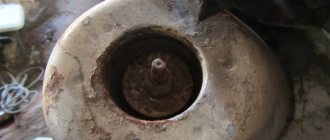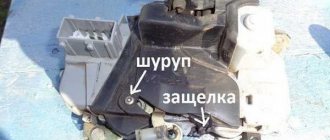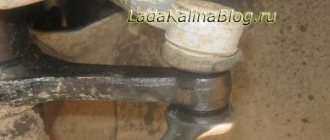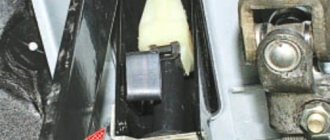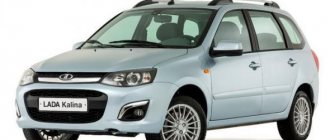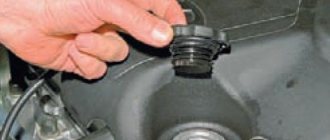In this article you will learn in detail about knocks and extraneous noise in the suspension and how to deal with it. Many novice car enthusiasts mistakenly believe that having bought a new car they will drive almost carefree according to their needs and not worry about anything, but this is absolutely not true; having bought any car, regardless of whether it is domestic or imported, there will be a knock on our Russian road. chassis, or even a roar will appear sooner or later. Now we will analyze in detail the reasons for the knocking.
Causes of knocking in the suspension on small bumps
There are quite a few reasons for knocking in the suspension, here is a list of components that cause an unpleasant sound:
- Ball joints.
- Steering.
- Silence blocks and stabilizer links.
- Silence blocks of levers and shock absorbers.
- Springs and shock absorbers.
- Shock absorber supports and bearings.
- Braking system.
Ball joints
The problem with ball joints has been and will remain on all cars, both foreign and domestic. It was understood especially well by the happy owners of domestic classics (VAZ 2101-2107), on which if the ball joint began to knock, the owners of these cars immediately put a spare ball joint in the trunk. On these cars, the problem of the ball joint was very acute, because after knocking for a week, the pin with the ball could jump out of its body and, at best, the car would be thrown off the road, and at worst, it could tip over onto the roof, since the wheel takes a horizontal position in relation to the road. On cars with front-wheel drive of domestic production and imported cars there is no such serious problem with the supports, but they have not lost the ability to “knock” when worn out.
There are practically no problems with replacing the ball joint on cars of our production; to do this, you just need to unscrew 2-3 bolts and one central nut, and it costs a penny, which cannot be said about many imported cars, on which the ball joint already comes with lever and you have to change the entire assembly.
How to check silent blocks?
A flat mount will be required for diagnosis. This will allow you to determine how badly these parts are worn. Using the mount, the lever will move in the longitudinal and transverse directions. If there is play or damage, then the front suspension silent blocks are to blame for the knocking.
Sometimes the levers can be collapsible. Then you can replace it with a silent block. To do this, the lever is dismantled, and then, using a special mandrel, the part is squeezed out. It is advisable to lubricate the new silent block before installation. The seating surface must also be cleaned. After installation, the knocking should stop.
Steering noise
Steering is also very often the cause of knocking in the suspension; steering tips deserve special attention. On domestic cars, on average, they last for a year, on imported ones, a little longer, but if, when checking the steering tips, you find even a slight play, then it is better to immediately change them. They are changed on all cars almost the same way; you just need to unscrew one nut and the tip itself, and don’t forget to visit the wheel alignment adjustment after replacing them. On cars with rear-wheel drive and all-wheel drive, the steering pendulum often breaks, which usually drums right next to the passenger’s feet; changing it won’t be too difficult either.
Silence blocks and stabilizer links
Silence blocks and stabilizer links are one of the most common causes of knocking in the suspension. On Russian-made cars with both front- and rear-wheel drive, they are fixed using rubber silent blocks, which even with slight wear begin to knock. Of course, nothing terrible will happen, but the knocking is quite frequent, unpleasant and annoying. On most imported cars, the stabilizer struts are attached to the lower arms using rods, which are made on the principle of steering ends and, of course, also tend to wear out and make an unpleasant sound.
Diagnostics of the condition of components and troubleshooting
After carrying out a visual inspection of the suspension of the Lada Kalina, which will allow you to find out the cause of the knocking, you can proceed to dismantling the faulty elements. For example, car shock absorbers. Diagnostics are carried out by placing the car over an inspection hole or using a jack. Particular attention is paid to elements adjacent to the body or car frame.
Diagnostics involves a thorough examination of the suspension elements, the presence of various damages, cracks and breaks on them. If a breakthrough is detected in the rubber protection of the steering tip, it must be repaired. Rubber seals are inspected for mechanical damage and those areas where there are breaks and cracks are identified.
As a result of a muffler breakage, a knock will be heard in the suspension. To identify the cause of such sounds, which may lie in the exhaust pipe, the muffler should be rocked in different directions. This is a quick way to diagnose the front suspension. After this is completed, you can proceed to suspension repair.
The chassis of a Lada Kalina car, like any other, must be in good condition, which will ensure safe operation of the vehicle.
The front suspension consists of: 1 — nut for securing the upper strut support; 2 - bolt; 3 — upper support of the front suspension strut; 4 — bearing of the upper support of the strut; 5 — upper insulating gasket of the spring; 6 — front suspension spring; 7 — protective casing; 8 — telescopic stand assembly; 9, 10 — nuts securing the strut to the steering knuckle; 11 — bolt with eccentric; 12 - bolt; 13 — steering knuckle; 14 — front wheel drive shaft; 15 — stabilizer bar; 16 - stretching; 17 — lever; 18 — ball joint; 19 — hub; 20 — hub fastening nut; 21 — brake disc; 22 — front suspension compression buffer; 23 — upper spring cup; 24 — compression stroke limiter of the upper strut support; 25 — travel limiter of the upper strut support; 26 — stabilizer strut mounting nut; N - reference size
Springs and shock absorbers
Springs and shock absorbers also tend to wear out and fail over time. The spring itself cannot knock, but if after the next blow to the suspension some strange knocking appears, then be sure to inspect the spring, if one coil breaks off, it will knock by itself, in this case there is only one way out - a replacement spring.
Shock absorbers knock if they are very worn, they can also punch if the bump stop is broken, here too there is only one way out - replacement.
Brakes as a source of knocking
Sometimes sounds coming from the suspension are actually coming from the brakes. It happens that a car enthusiast has checked everything and replaced everything that can be replaced. The front suspension layout has already been learned by heart, but the knocking was still there.
To make a diagnosis, you need to move. If the knocking noise disappears when braking, and when the pedal is released, it resumes again, then the brake pads are to blame. The same problems can occur after installing new pads.
If the car is knocking, do not rush to repair the chassis. Perhaps the extraneous sound is caused by a completely different reason. In this case, only a complete diagnosis can help. It may be enough to replace the front suspension silent blocks and the sound will disappear forever.
Braking system
Also, the reason for knocking in the front suspension on small bumps may be the braking system. The main causes of knocking in this situation are the springs in the brake pads, which over time experience so-called “metal fatigue” and constant rattling appears. This can be done easily by replacing the pads or springs.
Also, the reason for knocking in the front suspension on small bumps may also be hidden in the brake calipers themselves, when the movable bolts securing the second half of the caliper wear out. In this case, the bolts need to be replaced.
conclusions
As can be seen from the article, it is quite easy to find the reason for the knocking of the Lada Kalina’s suspension on small bumps. If you pay attention to the table, you can see that all possible options and methods for eliminating them are listed. It is also worth noting that it is necessary to regularly carry out maintenance and diagnostics of the car, and then the likelihood of this effect occurring is reduced.
Read more: Adjusting the Spicer UAZ Hunter axle
Especially the ball joints must be strictly monitored. Otherwise, the wheel may come off in the middle of the road. I have seen such scenes before.
Before a long trip in a Lada-Kalina Cross car, after undergoing maintenance, I discovered a knocking sound in the front axle, on the left, which was heard on uneven surfaces, in the form of a rattling sound. I arrived at the service station where I service my car, where I was informed that the steering rack had stretched and needed to be replaced. In addition, the service station told me that the rack is not in stock, but they know where this steering rack is. In general, I need to change it, and if I go a long distance, then anything can happen on the road. Depressed by this specialist’s conclusion, I decided to consult with my nephew, who turned out to be a familiar luminary - “Kulibin”, who, having examined my car, found the cause of the knocking: during maintenance (I told the technicians that I was going on a long trip), they inflated the left front wheel to 2.5 Atm., with the norm being 2.0, and the right front wheel was inflated to 1.85. In addition, in the left front wheel (which they re-mounted during maintenance, for balancing), someone left a nut, which, when moving, made a characteristic sound: “boom” - “boom” - “Boom”.
Today, July 23, 2018, I returned from a long trip, having covered 1,870 km, of which 250 km were sections of dirt roads (sand and crushed stone). There was no knocking or strumming.
Why the hell do we need your spam, you also write where and how you pooped on the road
Many of us, when purchasing a new Lada Kalina, probably noticed that when driving over small irregularities on the asphalt, and especially on a dirt road, there are small annoying muttering sounds reverberating through the body of the car. These sounds are especially audible when the window on the driver's side or on the right side is open. I wondered how to eliminate this shortcoming? After looking through the entire Internet and reading several forums, I began to experiment with the upper support of the front suspension strut: 1. I noticed that the cup of the upper support (limiter) did not fit tightly to the damping rubber of the support itself. I concluded that it needed a better fit and placed a rubber gasket under the cup of the upper support, cut in the form of a ring, and the cup (limiter) began to fit tightly through the rubber to the support body. The first trip showed a SEVERAL TIMES INCREASE in the VIBRATION TRANSMITTED TO THE BODY FROM THE SHOCKER. 2. I thought that things wouldn’t work out that way and began to figure out what was going on. It turns out that the cup of the upper support (limiter) should structurally touch the damping rubber only during rebound, i.e. when the wheel falls sharply down and has reached the limit of the stroke of the shock absorber rod, that is, during normal operation, the rubber damper to which the shock absorber rod is attached should work and the cup should not touch the rubber. 3. In short, I thought about it and decided to do this: I placed a 2 mm thick washer under the cup of the upper support (limiter), it turned out that now the cup does not touch the upper support and the gap between the cup and the rubber is about 2 mm. The trip showed that all sorts of knocks and noises from the front suspension when driving on a bad road immediately decreased. So let's get down to action:
Read more: Changing the oil in a Matiz mechanic box
1. Unscrew the nut securing the front strut shock absorber.
2. Take out the metal cup (LIMITER - according to the KALINA parts catalog).
3. WE START ASSEMBLY BACK, BUT before that we place (put) a washer on the shock absorber rod (under the cup) with a thickness of 2-3 mm. Before placing the washer, you need to sharpen the edges, otherwise the edges of the rubber will be eaten by this washer or find hemispherical washers. The dimensions of the washers are as follows: outer diameter 25-34mm, inner diameter 14-15mm. I installed hemispherical washers, they are located on the “classic” ones - on the top bolt of the front suspension, they press the silent blocks. Outer diameter – 38.5 mm, inner diameter – 14 mm. ,thickness 2mm. Sold in all auto parts stores. The issue price is 10 rubles/piece.
You can also do this experiment, find something like a seal and cut a soft washer around the edges of the cup:
4. Put the cup (limiter) back and tighten the nut securing the front strut shock absorber rod!
5. The cup (limiter) will rise by 2-3 mm and will not touch the rubber of the upper support of the front strut.
THOSE. THE NORMAL OPERATION OF THE SHOCK ABSORBER IS RESTORED WHEN ALL VIBRATIONS ARE DAMPENED AND ARE NOT TRANSMITTED TO THE KALINA BODY BY THE RUBBER DAMPER OF THE UPPER SUPPORT AND ONLY WHEN THE REBACK IS COMPLETE, THE CUP (LIMITER) COMES INTO OPERATION.
You can also experiment with the thickness of the washer, it may turn out to be the case. that the optimal thickness is 2-5 mm.
According to experimental data from potassium ducts, the best result is achieved when you put washers of these sizes: outer - 25mm, inner - 14.5mm, thickness 2.5mm. On my Kalina I have washers from “classic” silent blocks.
